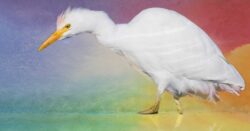A cattle egret sighting would have been almost unimaginable just five years ago (Picture: Supplied / Getty)
The weather is out of goose. The outlook was rain on a mild northerly and we have dressed accordingly.
But the forecast is wrong – it is warm, too warm for our layers, and there is barely a cloud in the sky.
It is the first weekend of October and we are at the south-east corner of the Isle Of Sheppey, arguably the wildest place in Kent, if not the entire south east.
The gated hamlet of Shellness is here, next to the naturist beach. The popular coastal town of Whitstable is across the Swale estuary, the North Sea is out to the east.
Weathered wooden groynes stick out from the sand like penitents queuing to bathe in the Ganges.
The WWII-era Maunsell Forts look like something from another planet (Picture: Alamy Stock Photo)
On the horizon we can see Maunsell Forts – World War II defences that bring to mind the alien craft of HG Wells’s War Of The Worlds.
Oystercatchers pipe and curlews ‘cur-lew’. The first of the brent geese have arrived from the Arctic north – smart, tidy, small and black. There are a dozen here now. Within two months there will be not far off a thousand.
Our hope had been to see the first of the raptor superstars that come down from Scotland to see out the colder months.
Hen harriers, the males ghostly and beautiful platinum – persecuted half to extinction by game-keepers fearful for their grouse.
Or merlins, our smallest falcons, that sit hunched on posts scanning for a pipit or a finch.
Or short-eared owls that hunt in the daytime on the most buoyant wings.
The cattle egret was once a rare sight in the UK (Picture: Alamy Stock Photo)
We see none of these. But we do see something that even five years ago would have been unimaginable.
And it’s a bittersweet experience because it’s difficult to disassociate from the profound effects of man-made climate change.
Egrets are part of the heron family. The grey heron will be familiar to many, seen stock-still up to its shins in urban ponds or lakes, spear-head bill ready to plunge into a fish, yellow eye fierce.
The effects of climate change means more cattle egret are being seen on our shores (Picture: Alamy Stock Photo)
Less common is the little egret, then the great white egret and then the cattle egret. All are fresh-out-of-the-washing-machine white. All have the same dagger bills. Other than their size, the main difference is the length of their neck.
According to the Kent Bird Report, published by the Kent Ornithological Society, there had been no little egrets recorded in the county until 1957. Now they breed here and 104 were seen on one day alone in 2020.
It’s a similar story for great white and cattle egret, if not on anywhere near the same scale. Neither are mentioned in the first KBR of 1952, while in the most recent – 2020 – the highest counts are of 12 for the former and 13 for the latter. Speak to older birders and they will talk of making special journeys to see – or ‘twitch’ – either.
More: Nature Calls
The reason for their advance west and northward from Africa and southern Europe is, depressingly, predictably, that it is now warmer here.
We see six this October morning on Sheppey – four adults, two, with dark bills, juveniles. The chances high, therefore, that they have bred here.
They stand by the creek edge, hunched like old men in overcoats until they stalk off, careful yet purposeful, lifting their feet high.
We stand awhile and watch them, these colonisers from the south, before we walk on ourselves, too warm under this October sky.
Do you have a story to share?
Get in touch by emailing [email protected].
MORE : Nature Calls: Lying in wait to see tens of thousands of birds soar in formation
MORE : Nature Calls: Marvel at the migrant hawker dragonfly’s aerial prowess
MORE : Nature Calls: Tracking down the long-tailed blue butterfly in Jersey
Each week Paul Dietrich flees the city in search of birds. This week it’s the… cattle egret.





